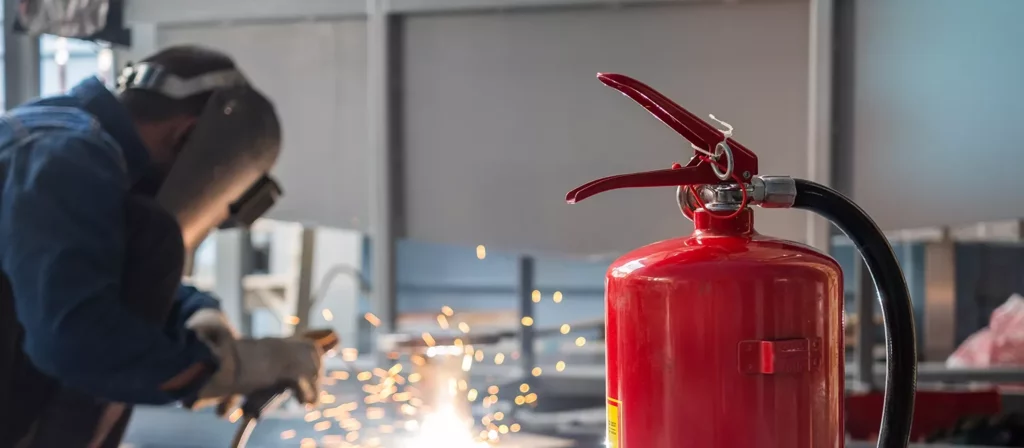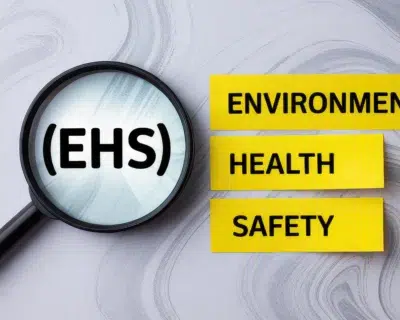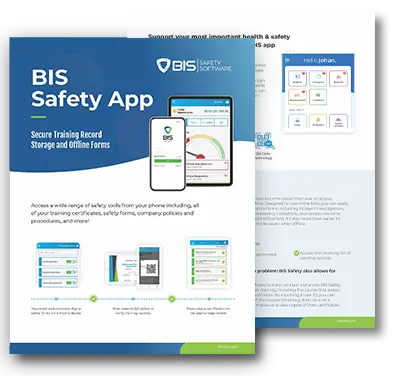
Why is Learning about Fire Safety Important?
Fires can be incredibly destructive, causing harm to property, injuries, and even loss of life. In the workplace, a fire not only endangers people but can also lead to job loss if offices or factories are destroyed and not rebuilt. That’s why understanding fire safety is crucial, and it all starts with proper training.
By receiving adequate training, workers can identify potential fire hazards and know how to react swiftly and effectively if a fire does occur. Without this training, even a minor incident can quickly escalate into a major disaster, causing devastating consequences.
Everyone faces risks when it comes to fires, but certain workers may be particularly vulnerable due to factors like their work environment or lack of familiarity with safety protocols and equipment.

Fire safety Training Covers a Range of Essential Topics, Including:
Understanding Fire Hazards: Key to Fire Safety Training
Fire safety training emphasizes the importance of recognizing potential fire hazards within the workplace. By understanding and identifying these hazards, workers can take proactive measures to prevent fires and ensure a safer environment for everyone. Let’s delve deeper into the various aspects of recognizing fire hazards:
Identifying Ignition Sources:
- Heaters: Faulty or improperly maintained heaters can pose a significant fire risk, especially in colder environments.
- Lighting: Overheated light fixtures or exposed wiring can lead to ignition if not properly installed or maintained.
- Open Flames: Any open flames, such as those from candles or gas stoves, should be closely monitored to prevent accidental fires.
- Electrical Equipment: Malfunctioning or overloaded electrical equipment, including computers, printers, and kitchen appliances, can spark fires if not addressed promptly.
- Welding or Grinding Equipment: Activities involving welding or grinding produce sparks that can ignite nearby combustible materials if precautions aren’t taken.
- Cigarettes or Matches: Smoking in prohibited areas or improper disposal of smoking materials increases the risk of fire, particularly in environments with flammable substances.
Identifying Fuel Sources:
- Furniture: Upholstered furniture and furnishings made of flammable materials can serve as fuel for fires, especially if located near ignition sources.
- Garbage: Accumulated trash or improperly disposed of waste can quickly ignite and spread fire throughout the workplace.
- Wood, Cardboard, and Paper: Combustible materials like wood, cardboard boxes, and paper documents should be stored properly to minimize the risk of fire.
- Plastic and Foam: Plastic products and foam insulation materials release toxic fumes when burned, posing additional risks to occupants’ safety.
- Flammable Liquids: Storage and handling of flammable liquids such as paint, varnish, and gasoline require careful attention to prevent accidental spills or ignition.
- Flammable Gases: Proper storage and ventilation are essential for managing flammable gases like propane to prevent leaks and potential fire hazards.
Fire Safety Risk Assessment:
In addition to identifying specific ignition and fuel sources, fire safety training also emphasizes the importance of conducting a thorough risk assessment. This assessment involves:
- Evaluating Emergency Routes and Exits: Ensuring clear pathways for evacuation in the event of a fire emergency.
- Assessing Fire Detection Systems: Testing and maintaining fire alarms and smoke detectors to ensure timely detection of fires.
- Inspecting Firefighting Equipment: Regular inspection and maintenance of fire extinguishers, sprinkler systems, and other firefighting equipment to ensure functionality.
- Managing Dangerous Substances: Proper storage, handling, and disposal of hazardous materials to minimize fire risks.
- Developing Emergency Evacuation Plans: Establishing protocols for evacuating employees and visitors safely during a fire emergency.
- Addressing Vulnerable Populations: Considering the needs of individuals with disabilities or mobility limitations when developing evacuation plans.
- Ensuring Effective Communication: Establishing clear communication channels for disseminating fire safety information and emergency procedures to all employees.
Importance of Fire Safety Training:
By incorporating fire safety training into workplace practices, organizations empower employees to identify and mitigate potential fire hazards effectively. This proactive approach not only enhances workplace safety but also reduces the likelihood of fire-related incidents and their associated consequences.
Fire Safety Training Courses:
- Fire Prevention
- Use of Fire Extinguishers
- Fire Watch Training
- Fire Extinguisher (OSHA)
- Fire Watch (OSHA)
Conducting a Fire Safety Risk Assessment:
A vital aspect of fire safety training involves conducting thorough fire safety risk assessments within the workplace. This proactive approach helps identify potential hazards, assesses existing controls, and formulates effective strategies to mitigate fire risks. Let’s explore the key components of conducting a fire safety risk assessment:
Evaluation of Emergency Routes and Exits:
- Clear Pathways: Ensure that emergency routes and exits are unobstructed and clearly marked to facilitate swift evacuation during a fire emergency.
- Accessibility: Assess the accessibility of emergency exits for individuals with disabilities or mobility impairments to ensure inclusive evacuation procedures.
Examination of Fire Detection and Warning Systems:
- Functionality: Regularly test and maintain fire alarms, smoke detectors, and other detection systems to ensure they are operational and capable of promptly alerting occupants in the event of a fire.
- Placement: Evaluate the placement of detection devices to ensure optimal coverage throughout the workplace, including areas prone to fire hazards.
Inspection of Firefighting Equipment:
- Maintenance: Regularly inspect and maintain fire extinguishers, sprinkler systems, fire hoses, and other firefighting equipment to ensure they are in working condition and readily accessible in case of a fire.
- Training: Provide employees with proper training on how to use firefighting equipment effectively, including identifying the appropriate type of extinguisher for different classes of fires.
Management of Dangerous Substances:
- Storage: Implement proper storage protocols for hazardous materials to prevent accidental spills or leaks that could lead to fires.
- Labeling: Ensure hazardous substances are properly labeled and stored in designated areas, with clear instructions for handling and disposal.
Development of Emergency Evacuation Plans:
- Evacuation Procedures: Establish clear and concise evacuation procedures, including designated assembly points outside the building to account for all employees and visitors during an evacuation.
- Training and Drills: Conduct regular fire drills and provide training to employees on evacuation procedures to ensure they are familiar with the protocols and can respond effectively in an emergency.
Consideration of Vulnerable Populations:
- Special Needs: Take into account the needs of individuals with disabilities or special requirements when developing evacuation plans, ensuring they have appropriate assistance and support during emergencies.

Preventing Workplace Fires: A Proactive Approach
Preventing workplace fires is paramount to maintaining a safe and secure environment for employees and visitors alike. Through comprehensive fire safety training, individuals can learn practical measures to minimize fire risks and mitigate potential hazards effectively.
Keeping the Workplace Clean:
- Litter Control: Regularly remove litter and debris from work areas to eliminate potential fuel sources for fires.
- Clutter Management: Maintain organized workspaces to prevent obstruction of emergency exits and access to firefighting equipment.
Responsible Smoking Practices:
- Designated Smoking Areas: Designate specific areas for smoking and provide proper receptacles for extinguishing smoking materials safely.
- Prohibition in Hazardous Areas: Prohibit smoking in areas where flammable materials or chemicals are present to reduce the risk of accidental ignition.
Hazard Identification and Signage:
- Clear Signage: Install clear and visible signage to identify potential fire hazards and emergency equipment, such as fire extinguishers and emergency exits.
- Marking Hazardous Areas: Use appropriate signage to indicate areas with flammable materials or machinery that may pose fire risks.
Equipment Maintenance:
- Regular Inspections: Conduct routine inspections of machinery and equipment to identify and address potential fire hazards, such as overheating or electrical faults.
- Lubrication and Cleaning: Ensure proper lubrication and cleaning of equipment to prevent friction sparks and reduce the likelihood of fires.
Safe Handling of Materials:
- Proper Storage: Store flammable materials, such as paints and solvents, in designated areas equipped with appropriate ventilation and containment measures.
- Waste Disposal: Dispose of oily rags and other combustible waste in metal containers to minimize the risk of spontaneous combustion.
Electrical Safety:
- Prompt Repairs: Address faulty wiring and malfunctioning electrical equipment promptly to prevent electrical fires.
- Cord Management: Avoid overloading electrical outlets and ensure proper placement of cords to prevent damage and reduce fire risks.
Employee Training:
- Awareness Programs: Provide comprehensive fire safety training to all employees, emphasizing the importance of fire prevention measures and proper emergency procedures.
- Regular Refreshers: Conduct periodic refresher courses to reinforce safety protocols and ensure employees remain vigilant in fire prevention efforts.

Responding to Fires:
In the event of a fire, how individuals respond can make a significant difference in minimizing damage and ensuring everyone’s safety. Fire safety training equips employees with the knowledge and skills necessary to respond promptly and effectively to fires, emphasizing the importance of swift action and clear communication.
Familiarity with Emergency Procedures:
- Understanding the Emergency Plan: Employees should be familiar with the company’s emergency plan, including evacuation routes, designated muster areas, and emergency contact information.
- Role Awareness: Each employee should understand their role in the emergency plan and know what actions to take in the event of a fire.
Activation of Fire Alarms:
- Immediate Response: Upon discovering a fire or hearing the fire alarm, employees should promptly activate the alarm to alert others and initiate the evacuation process.
- Location Awareness: Employees should know the location of fire alarm pull stations throughout the workplace and how to use them effectively.
Safe Evacuation Procedures:
- Prompt Evacuation: Employees should leave the area immediately upon hearing the fire alarm, closing doors behind them to contain the fire and smoke.
- Designated Muster Areas: Employees should proceed to designated muster areas outside the building to ensure accountability and facilitate headcounts.
Handling Heat and Smoke:
- Safety Precautions: If encountering heat or smoke while evacuating, employees should stay low to the ground where the air is less toxic and cover their nose and mouth with a cloth if possible.
- Alternative Routes: In case primary evacuation routes are blocked, employees should be aware of alternative escape routes and exits.
Utilizing Fire Extinguishers:
- Appropriate Use: Employees trained in the proper use of fire extinguishers can attempt to extinguish small fires if safe to do so.
- Type Recognition: Employees should understand the different classes of fires and which type of extinguisher is suitable for each.
Cooperation and Communication:
- Teamwork: Cooperation among employees is crucial during a fire emergency, with individuals assisting each other in evacuating safely.
- Clear Communication: Effective communication ensures that everyone is informed of the fire emergency and follows established procedures.
For more on fire safety in general, visit the OSHA fire safety page.








































